The basics of IP whitelisting and how does it work?
What is IP whitelisting?
IP whitelisting, also known as IP address whitelisting, is a security mechanism used to restrict access to a system, network, or service based on the IP addresses that are permitted to connect to or interact with it. In simple terms, it is a mechanism that enables organizations to create a list of trusted IP addresses.
Here are some key points to understand about IP whitelisting:
1. Trusted Access: IP whitelisting provides a way to grant access privileges to specific IP addresses that are deemed trustworthy or authorized.
2. Increased Security: By limiting access to trusted IP addresses, organizations can reduce the risk of unauthorized access, malicious attacks, and data breaches.
3. Access Control: IP whitelisting allows organizations to have granular control over who can access their systems, networks, or services. It can be implemented at various levels, such as firewalls, servers, applications, or specific web pages.
4. Filtering Mechanism: The system compares the source IP address of incoming connections to the whitelist. The connection is permitted if the IP address matches one of the entries in the whitelist. Otherwise, it may be denied or subjected to additional security measures.
5. Prevention of Unauthorized Activities: IP whitelisting restricts access to known and trustworthy IP addresses, which helps stop unauthorized activity including unauthorized login attempts, brute-force assaults, spamming, or other malicious actions.
6. Maintenance and Updates: Organizations need to regularly review and update their IP whitelists to ensure that the trusted IP addresses remain current and relevant.
How does an IP whitelist work?
An IP whitelist works by allowing access only to specific IP addresses that have been explicitly designated as trusted or authorized. Here’s a breakdown of how an IP whitelist operates:
1. Identification of Trusted IP Addresses: The organization determines which IP addresses are considered trusted and authorized to access their systems, networks, or services.
2. Creation of Whitelist Rules: The organization creates a set of rules or configurations that define the whitelist.
3. Whitelist Verification: The system compares the source IP address with the entries in the whitelist.
4. Access Control Actions: Depending on the configuration, the actions taken when an IP address is not on the whitelist can vary. It can be as simple as blocking the connection or as complex as adding additional authentication steps, setting off alarms, or subjecting the connection to more thorough security assessments.
5. Monitoring and Maintenance: The organization regularly monitors the whitelist and updates it as needed. Changes may include adding or removing IP addresses, adjusting whitelist rules, or responding to any changes in trusted entities or access requirements.
6. Flexibility and Granularity: IP whitelisting offers flexibility in defining access control based on specific IP addresses or IP address ranges. This allows organizations to have granular control over who can access their resources and provides an additional layer of security.
The Benefits of IP whitelisting
Why IP whitelisting is a wise decision for your company if you want to strengthen your security measures has already been discussed. Here are some other advantages to think about:
Simplicity: IP whitelisting makes it possible for any business to improve network security, and it only requires a few easy actions.
Better access control: One practical way to stop unauthorized access to particular network resources is by whitelisting specific IP addresses.
IP whitelisting gives you better visibility and control over who accesses company resources.
Saving money: You can use a public internet connection securely without having to create your own infrastructure.
6 Certifications that can positively impact email deliverability
1. Return Path Certification:
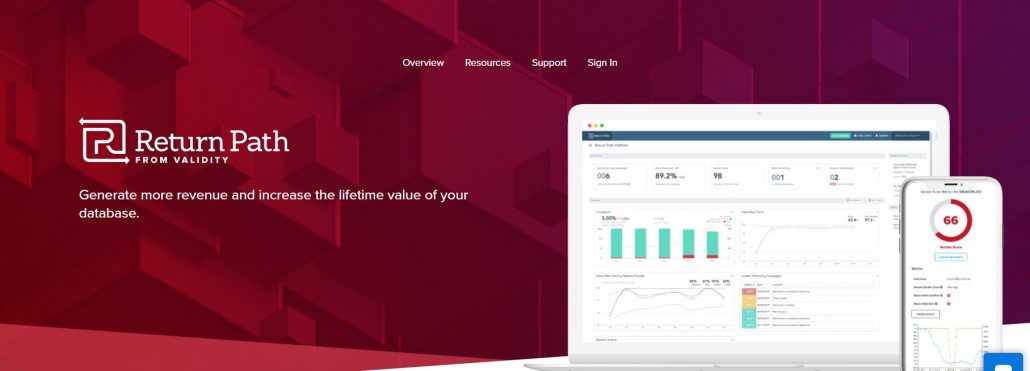
Return Path offers a certification program that assesses the sending practices and reputation of email senders. Achieving Return Path Certification can improve deliverability by signaling to mailbox providers that the sender follows industry best practices.
One of the primary goals of Return Path Certification is to boost email deliverability. Deliverability refers to the successful delivery of emails to recipients’ inboxes rather than being filtered as spam or junk mail.
Here are the key points to understand about Return Path Certification:
1. Email Deliverability Enhancement: Return Path Certification aims to enhance the deliverability of email messages by establishing a positive sender reputation.
2. Sender Reputation and Trust: Return Path Certification focuses on building and maintaining a strong sender reputation.
3. Enhanced Inbox Placement: With Return Path Certification, certified senders gain the advantage of preferential treatment when it comes to inbox placement.
4. Monitoring and Compliance: Return Path Certification involves ongoing monitoring and evaluation of sender practices to ensure compliance with the program’s requirements.
5. Improved Email Metrics: Return Path Certification can positively impact email performance metrics, such as open rates, click-through rates, and conversions.
6. Industry Recognition: Return Path Certification is well recognized and respected in the email industry. It is used by ISPs, mailbox providers, and filtering companies as a trusted source of information about sender reputation and email legitimacy.
7. Program Requirements and Fees: It has specific requirements and guidelines that senders must meet to be eligible for certification. There are associated fees for participating in the certification program.
2. Certified Senders Alliance (CSA)
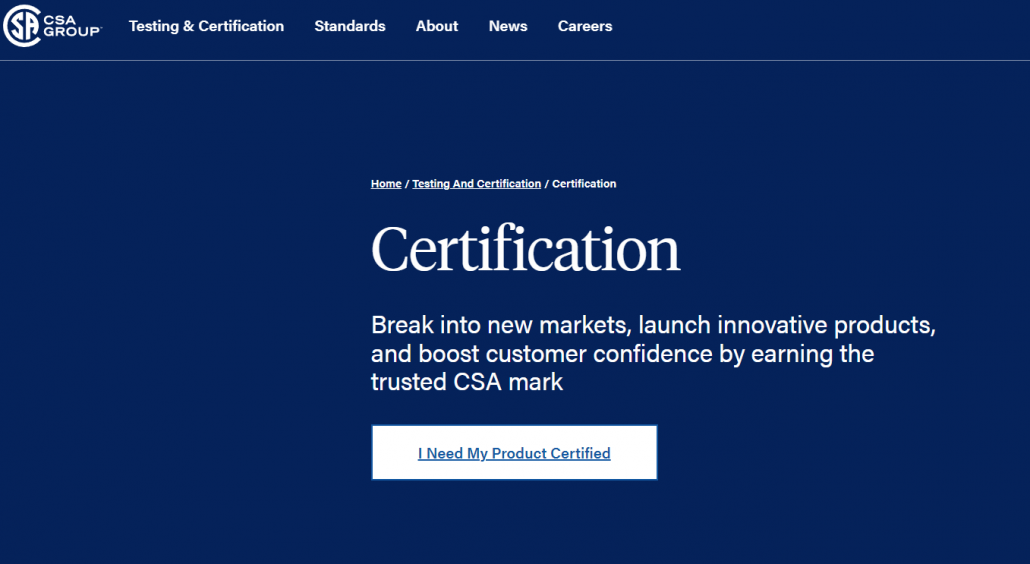
The Certified Senders Alliance (CSA) is an industry initiative based in Germany that aims to improve email deliverability and combat spam. Ultimately leading to better inbox placement for their emails.
The CSA operates by providing a certification process for email senders who adhere to their guidelines and meet their requirements. To become certified, senders must demonstrate compliance with certain criteria and best practices in email sending.
The key features of the Certified Senders Alliance (CSA) include:
1. Whitelist Program: CSA operates as a whitelist program that allows email senders to demonstrate their legitimacy and commitment to best practices.
2. Verification Process: CSA verifies the sending practices of participating organizations to ensure compliance with industry standards and guidelines.
3. Sender Reputation Monitoring: CSA continuously monitors the reputation of certified senders to maintain a high level of trust and deliverability.
4. Spam Mitigation: CSA helps combat spam by allowing only reputable senders to access the whitelist.
5. Enhanced Deliverability: Being on the CSA whitelist signals to mailbox providers that an email sender is trustworthy, leading to improved chances of email deliverability to recipients’ inboxes.
Overall, the Certified Senders Alliance offers a whitelist program and resources. Which help legitimate email senders enhance their deliverability, protect their brand reputation, and ensure responsible email communication practices.
3. Messaging, Malware and Mobile Anti-Abuse Working Group (M3AAWG):
The (M3AAWG) fights online abuse, including spam, malware, phishing, and messaging system abuse.
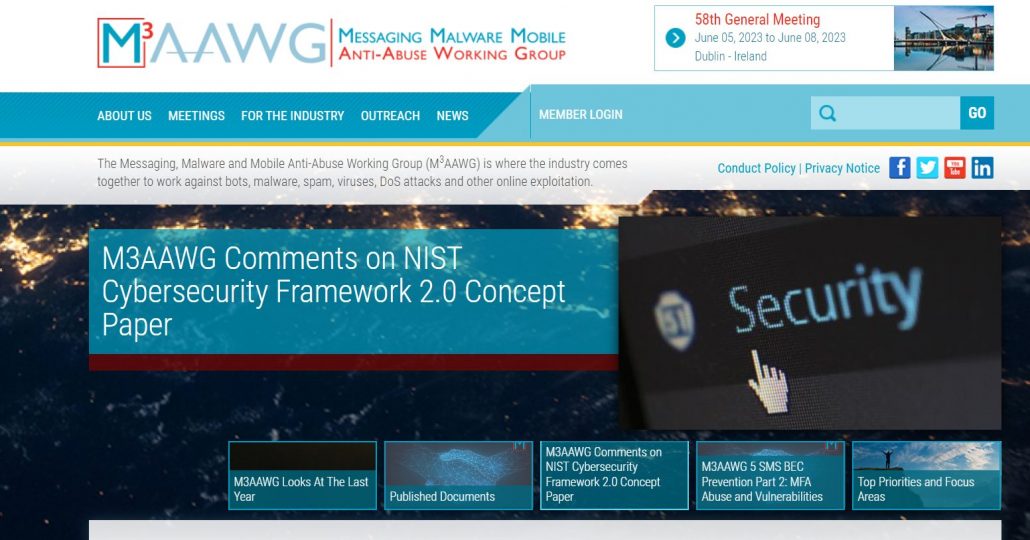
Here’s an explanation of M3AAWG in more detail:
1. Collaborative Industry Group: M3AAWG is a collaborative group that brings together a wide range of industry stakeholders, including ISPs, email service providers, technology companies, security vendors, researchers, and government agencies.
2. Abuse Prevention and Mitigation: M3AAWG focuses on developing and sharing best practices, guidelines, and industry standards to prevent and mitigate abuse in messaging systems, such as email, instant messaging, and voice communication, as well as in mobile networks.
3. Cross-Disciplinary Approach: M3AAWG takes a cross-disciplinary approach to address abuse issues, combining technical expertise, policy considerations, and legal aspects to combat evolving threats effectively.
4. Information Sharing and Education: M3AAWG facilitates information sharing and education through working groups, committees, and regular meetings. Members exchange insights, research findings, and best practices to stay updated on emerging threats and effective countermeasures.
5. Collaborative Problem Solving: M3AAWG enables collaborative problem-solving by fostering cooperation and dialogue among industry players. Allowing them to share experiences, strategies, and solutions for abuse prevention and mitigation.
It brings together industry stakeholders such as ISPs, email service providers, security vendors, and government agencies to develop best practices, share information, and collaborate on solutions to protect users and improve the security of messaging and mobile platforms. M3AAWG plays a vital role in promoting cooperation, sharing knowledge, and advocating for a safer online ecosystem.
4. Email Experience Council (EEC):
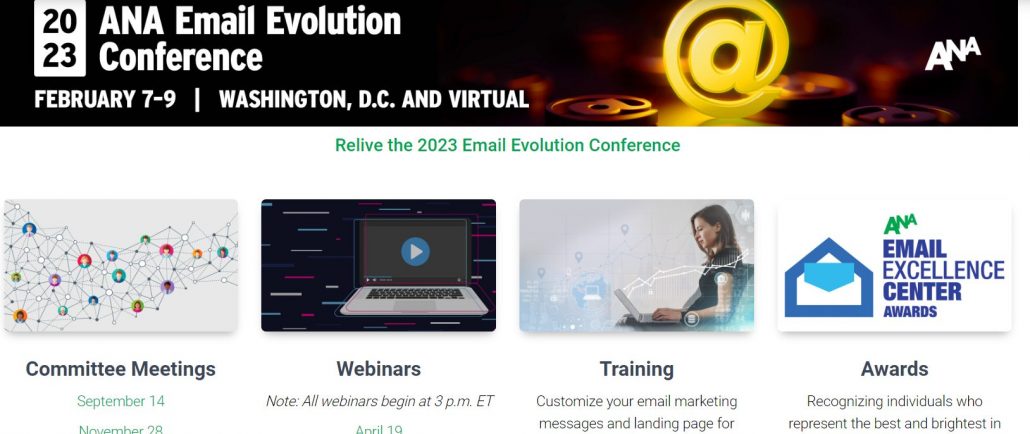
The Email Experience Council (EEC) is a global professional organization dedicated to advancing the email marketing industry and promoting best practices in email communications.
One of the primary purposes of the EEC is to educate and advocate for the value of email as a powerful marketing and communication channel. Through its educational programs, resources, and events, the EEC helps marketers enhance their understanding of email marketing.
Here are the main features of the EEC:
1. Industry Education and Resources: The EEC provides access to educational resources, including best practices, guidelines, case studies, and research reports.
2. Networking and Collaboration: The EEC facilitates networking and collaboration among email marketing professionals. Members can connect with industry experts, thought leaders, and peers through events, forums, and online communities.
3. Thought Leadership and Advocacy: The EEC acts as a platform for thought leadership in the email marketing industry. It conducts research, publishes insights, and advocates for best practices and industry standards.
4. Industry Recognition and Awards: The EEC recognizes excellence in email marketing through its annual awards program. Members have the opportunity to showcase their innovative campaigns, strategies, and achievements, gaining industry recognition and exposure.
5. Access to Email Service Providers and Vendors: The EEC provides access to a network of email service providers, vendors, and solution providers. Members can explore partnerships, discover new tools and technologies, and access exclusive offers and discounts from EEC-approved providers.
6. Compliance and Deliverability Support: The EEC assists members in navigating compliance requirements and improving email deliverability. It offers guidance on data protection, privacy regulations, and email authentication protocols, ensuring members adhere to industry standards and best practices.
7. Collaboration with Industry Stakeholders: The EEC collaborates with industry stakeholders, including policymakers, regulators, and technology providers.
By leveraging these key features, members of the Email Experience Council can enhance their email marketing strategies, improve deliverability, stay informed about industry trends, and connect with a vibrant community of professionals in the field.
5. Email Sender & Provider Coalition (ESPC):
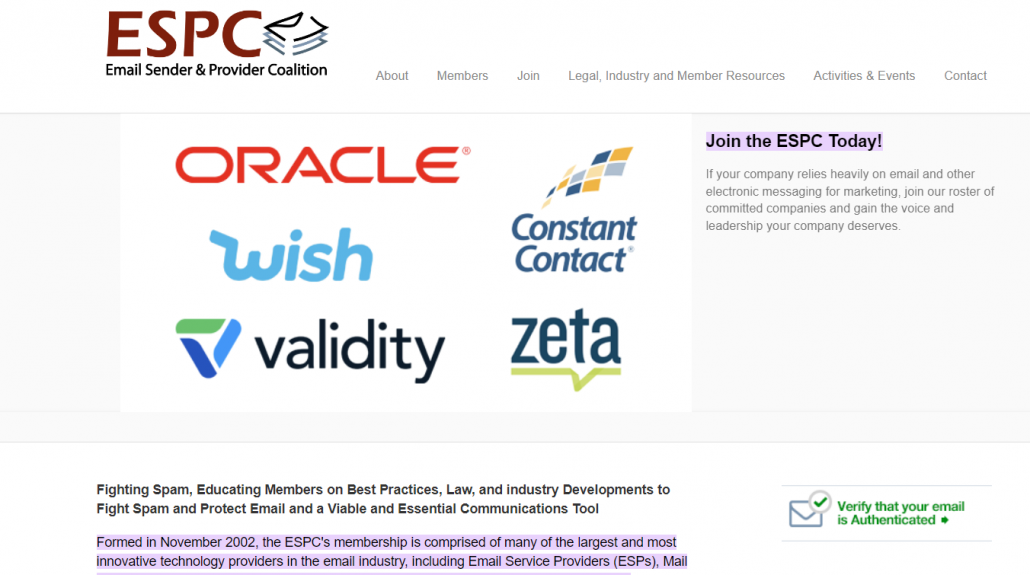
The ESPC is an industry association focused on promoting best practices in email deliverability. They provide resources, guidelines, and advocacy to help improve email deliverability and combat spam.
The ESPC was formed with the goal of fostering cooperation and dialogue between email senders. And email service providers to improve the overall email ecosystem.
The key features of the Email Sender & Provider Coalition (ESPC) include:
1. Industry Collaboration: The ESPC brings together email senders, email service providers, and other industry stakeholders to collaborate on addressing common challenges and promoting responsible email practices.
2. Advocacy and Policy Influence: The coalition actively engages with policymakers, regulatory bodies, and industry organizations to shape policies, legislation, and technical standards related to email. It advocates for the interests of legitimate email senders and providers.
3. Combatting Email Abuse: The ESPC works towards reducing email abuse, including spam, phishing, and other malicious activities. It develops and promotes best practices to combat unwanted and unsolicited email, protecting both senders and recipients.
4. Education and Resources: The ESPC provides educational materials, guidelines, and resources to help email senders. And providers stay informed about industry trends, emerging technologies, and best practices. This knowledge sharing promotes better email practices and awareness of email-related issues.
5. Email Authentication Adoption: The ESPC encourages the adoption of email authentication protocols such as SPF, DKIM, and DMARC. These protocols help verify the authenticity of email senders, protect against spoofing and phishing, and enhance overall email security.
Overall, the Email Sender & Provider Coalition serves as a platform for industry collaboration, advocacy, and education, working towards a more secure, reliable, and trustworthy email environment.
6. Institute for social Internet Public Policy (ISIPP)
ISIPP: Enhancing Email Deliverability in Simple Terms
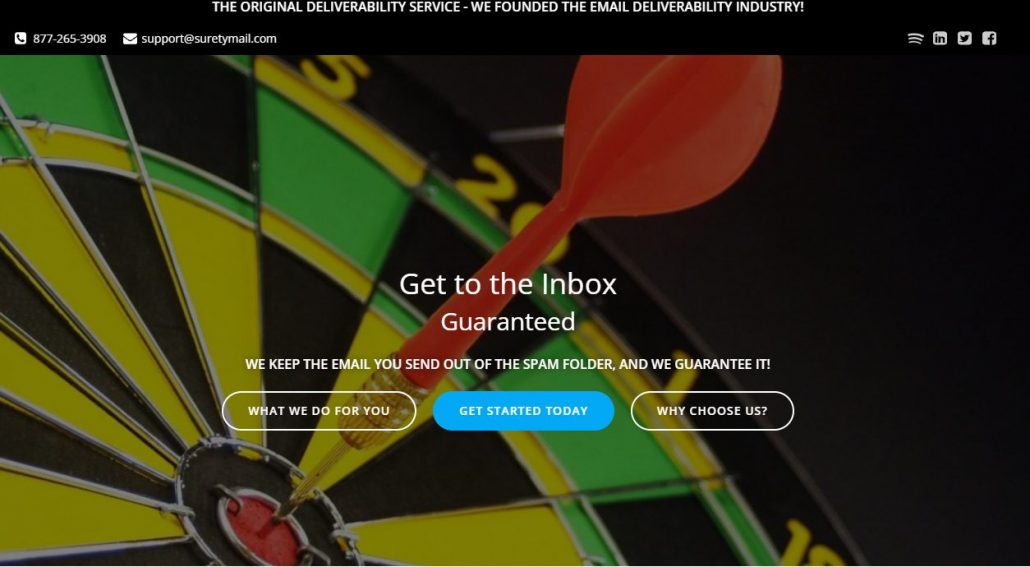
Email deliverability is a crucial aspect of successful email marketing campaigns. One way to improve deliverability and ensure that your emails reach recipients’ inboxes is by obtaining whitelisting certification.
ISIPP reputation services is a trusted accreditation that demonstrates your commitment to following email best practices and maintaining a high level of email sending reputation. When you achieve ISIPP Whitelisting Certification, your emails receive a seal of approval that tells email service providers (ESPs) that you are a legitimate and trustworthy sender.
By going through the certification process, ISIPP evaluates your email practices, such as how you handle subscriber consent, email content, and compliance with anti-spam regulations. They also check for email authentication protocols like SPF and DKIM.
Once you pass their rigorous evaluation, ISIPP adds your sending IP to their Good Senders List (GSL). Being on this list increases the chances of your emails bypassing spam filters and landing directly in the recipients’ inboxes.
ISIPP reputation services helps improve email deliverability, reduces the risk of false positives (legitimate emails marked as spam), and enhances the overall reputation of your email program.
However, ISIPP can assure you that they deal directly and on your behalf with all mailbox providers, regardless of whether they automatically utilize ISIPP data or not. Gmail, AOL, Yahoo, Hotmail, Comcast, and more are all included in this.
Email authentication protocols
Email authentication protocols, including SPF, DKIM, and DMARC, play a crucial role in enhancing email deliverability. And combatting spoofing and phishing attacks. Here’s an explanation of each protocol:
1. SPF:
Purpose: SPF (Sender Policy Framework) verifies that the sender’s IP address is authorized to send emails on behalf of a specific domain.
Implementation Process: SPF uses DNS TXT records to specify authorized IP addresses or domains for email sending.
Benefits: SPF helps prevent email spoofing and protects the reputation of the sending domain. It allows receiving mail servers to verify the authenticity of the sender and reduces the likelihood of emails being marked as spam.
2. DKIM:
Purpose: DKIM (DomainKeys Identified Mail) adds a digital signature to each email to verify its integrity and authenticity.
Implementation Process: DKIM involves generating a pair of cryptographic keys (private and public). The private key is used to sign outgoing emails, while the public key is published in DNS as a TXT record.
Benefits: DKIM enables the recipient’s server to verify that the email content has not been tampered with during transit and that it genuinely originated from the stated domain. It improves email deliverability and builds trust with ISPs and email providers.
3. DMARC:
Purpose: DMARC (Domain-based Message Authentication, Reporting and Conformance) builds upon SPF and DKIM to provide domain-level email authentication and reporting capabilities.
Implementation Process: DMARC requires configuring a DNS TXT record that specifies the domain’s email authentication policies. Such as, what actions to take for failed authentication and where to send aggregated reports.
Benefits: DMARC helps prevent domain spoofing and email phishing attacks. It allows domain owners to specify how receivers should handle emails that fail SPF or DKIM checks. It also provides valuable reports on email authentication results, aiding in identifying and mitigating unauthorized email senders.
Together, SPF, DKIM, and DMARC provide a layered approach to email authentication. By implementing these protocols, organizations can improve email deliverability, reduce the chances of their emails being marked as spam or phishing attempts, and protect their brand reputation.
Conclusion
While IP whitelisting is a powerful tool, it should be used responsibly and in conjunction with other email security measures. It is important to strike a balance between ensuring legitimate emails reach their destination and protecting against potential email threats. And you can also practice warming up IP which is also a best alternative to Whitelisting IP. So checkout our article on “Secret of IP warming- plans, schedule, strategy and pitfalls“
In conclusion, by understanding and leveraging IP whitelisting, organizations can enhance their email deliverability, build trust with recipients, and safeguard their email communications. Embracing this fundamental aspect of email deliverability empowers businesses to create better email experiences, strengthen their brand reputation, and foster meaningful connections with their audience.

Leave a Reply
Want to join the discussion?Feel free to contribute!